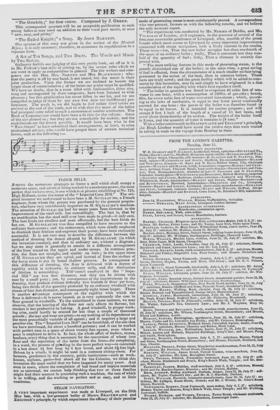FLOUR MILLS.
AMONG the numerous attempts to frame a mill which shall occupy a moderate space, and admit of being worked by a moderate power, the most perfect that we have seen, is one which is at present exhibiting at No. 175, High Holborn, under the name of the " Imperial Corn Mill.' The ori- ginal inventor we Understand to have been a M. GUILLAUME, a. French engineer, from whom the patent was purchased by the present proprie- tors, who have very considerably improved on M. GVILAUNE'S machine. The attention of Guru-seam bad for many years leen directed to the improvement of the steel mill, but unavailingly. The fact is, that by no modification has the steel mill ever been made to grind-it only cuts. The best kinds cut smallest and most effectually, but the best kinds do but cut. N. GUILLAUME was thus compelled to have recourse to the ordinary burr-stones ; and his endeavours, which were chiefly employed to diminish their friction and augment their power, have been eminently successful. It is not very easy to describe the difference between the method of dressing the stones adopted by N. GUILLAUmE (in which the invention consists), and that in ordinary use, without a diagram ; but we may state it generally to consist in a different, arrangement of the lines traced on the upper and under stones. In common prac- tice, the, lines are straight, and similar on both ; in the upper stone of M. GUILLAUME they are spiral, and instead of lines the surface of the lower stone is cut in broad shallow grooves. In consequence of this difference of dressing, the flour is delivered with a degree of rapidity which is unknown_ in ordinary mills, and the diminution of friction is astonishing. Thu-sten-a essasli,xyed in the " Impe- rial Mill" are two feet diameter, and they can be driven with ease by a small pony ; yet, by consequence of the improvement in the dressing, they produce without difficulty two bushels of flour per hour, being two thirds of the quantity produced by an ordinary windmill with stones of four feet diameter, and consequently eight times larger. There is another advantage consequent on the rapidity with which the flour is delivered-it is never heated, as is very commonly the case in flour ground in windmills. To the uninitiated in these matters, we may observe, that the beating of the flour not only afflicts its flavour, but renders it less productive in baking. A good windmill, in proper work- ing trim, could hardly be erected for less than a couple of thousand pounds ; the tear and wear are great-to say nothing of its dependence on the most proverbially variable of all agents ; and it requires a large and peculiar site. The "Imperial Corn Mill" can be furnished, of the size that we have mentioned, for about a hundred guineas; and it can be worked with perfect ease in a space of about twenty feet square, even where a pony is employed to drive it. In fact, the whole affair of feeders, stones, boulters, every thing that is necessary for the conversion of wheat into flour and the separation of the latter from the bran-for completing, in a word, the process of grinding in the most perfect way-is contained in a box about 44 feet long by 4 feet broad, and about 5i feet high. Driven by a winch, it might be used in a common sitting-room.. For farmers, gentlemen in the country, public institutions-such as work- houses, asylums, gaols-but above all for the Colonies, we think this invention the most useful that we have inspected for many years. And even in town, where the complaints of bad bread and impure materials are so universal, we cannot help thinking that two or three families might find their account in possessing such a machine, the cost of which is so trilling, and the working so perfect and so easy, and so little cumbrous.


























 Previous page
Previous page